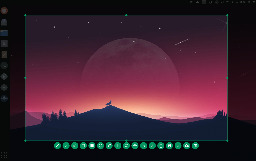Flameshot, an Open Source screenshot software



Features:
- Highly customizable
- In-app screenshot editing
- Upload to online platforms
- Command-line interface (CLI)
Platforms:
- Linux
- Windows
- MacOS
Link: flameshot.org.
You are viewing a single comment



Features:
Platforms:
Link: flameshot.org.
Doesn't seem like people think this works consistently on wayland, which was what made the post sound a lot more interesting. Hopefully every desktop will soon get full wayland support and be able to take screenshots without it not working. It seems like getting screenshots in wayland is difficult because of the security stuff.
It works flawlessly. Yes, currently it takes a bit of tweaking to get it working on Wayland, but once you nail it, flawless and so freaking useful. Once I started using it I find every other screen shot app lacking.
So if you have to get it working on Wayland, I don't think it works flawless. What exactly did you do?
I agree, but flawless does apply after the tweak/workaround is completed.
After this, just make the call from:
instead of:
instead of:
So why do that? Seems like you're just piping the output to null?
Apparently (from what I was able to gather, but I'm certainly no dev) that nullifies the part of Gnome in Wayland that makes it fail and not capture.
Whatever the case, it's been working flawlessly for me since Fedora 38 on Gnome 44.
/dev/null is a special file in the Linux filesystem that contains only 0s which aren't actually stored anywhere physically.
People often redirect data there in shell scripts to get rid of it without sending it anywhere else.
Usually data is either redirected with pipes to another command, or it's saved to some file (or used to manipulate a file by typing the little arrows in Shell scripts, >, standard output). This one seems to just reference a file (at least for the last line).
If you wanna get some dev skills, you can understand just one concept to do it and read basic code like this (especially Bash or Python, or a special coding language called Lisp). Be careful though, because this one concept is dangerous in that it can literally send you insane by altering your worldviews as what you can do with it grows. It's not necessarily an accurate representation of physical reality; for that you need science.
Are you ready? I hope you are lol
A computer is like one big hollow orb full of other little hollow orbs. They each contain concepts, conceptual data (like in mathematical Lambda Calculus), along with possibly other hollow orbs (coding procedures) that reintegrate with this data. You can store basically any concept in them and have the computer act it out when you're good at doing it. Lisp programming (where everything is in brackets) acts quite directly like this, and this is the main way I've thought about coding stuff.
Terry Davis probably used this concept (but not Lisp) to make his own operating system from scratch, which drove him insane. He thought it was perfect and in a way holy, even though it wasn't. Hope that helped lol.
Thanks for taking the time to explain this in detail. I have been wanting to get into the actual understanding of Linux commands to a deeper level for years now, but with 2 jobs, 3 kids, 3 dogs and church, what little free time I've had I tend to spend either playing some video games or sleeping.
You are right, I should get up off my ass and continue learning, and I will start today, by not entering commands and scripts that I find in the internet blindly (which is what I've been doing) but actually finding out what each part does before doing so.
I really liked it but unfortunately I was not able to get it to work on Wayland (with Hyprland) at all.
Does Spectacle work well with Wayland?